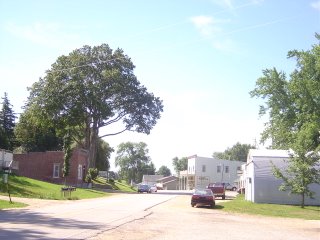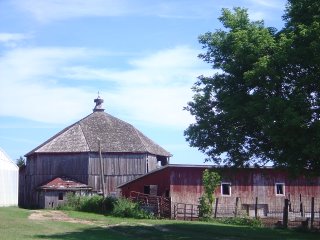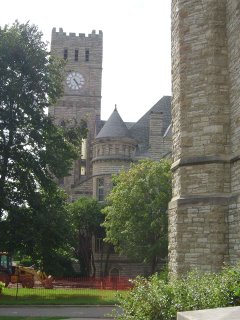Monday, August 28, 2006
Northern Iowa, Southern Minnesota
 I head up back roads through towns named New Vienna and Luxemburg and meet the Mississippi again at Guttenberg, Iowa, where the road plunges over a cliff back down to the flood plain. After dinner it gets dark, and I either miss a sign for the Great River Road or it isn’t there, and I find myself wandering around under an Iowa moon, past a county fair that’s letting out and down one gravel road after another, each twistier and more rutted than the last.
I head up back roads through towns named New Vienna and Luxemburg and meet the Mississippi again at Guttenberg, Iowa, where the road plunges over a cliff back down to the flood plain. After dinner it gets dark, and I either miss a sign for the Great River Road or it isn’t there, and I find myself wandering around under an Iowa moon, past a county fair that’s letting out and down one gravel road after another, each twistier and more rutted than the last.Suddenly the sign in front of me announces US 52, and it’s a measure of how bad things had gotten that I’m absolutely convinced the sign has north and south backward. I choose to believe it, and it turns out to be right. I have no idea what happened. The map says I’m not following the route I wanted to, but I don’t really have much choice but to follow it at the moment.
Yes, it's a surprising and memorable, as well as valuable, experience, etc. But strictly speaking these are not the woods.
Up US 52, five miles outside of a town called Postville, Iowa, I pass a gigantic billboard for El Sabor Latino grocery. I arrive in the town at about 10:00 and there it is, the biggest grocery in town, right next to the pasteleria. Which I mention only by way of recording my surprise, regular and ongoing during this trip, at the way pockets of Mexican culture are located all over the midwest - even here in small-town Iowa, where there aren't the industries I would immediately think of as attracting immigrants. Or where, for that matter, my snobbish assumption would have been that the arms weren't be quite as open. It has, at the least, altered my perception, heretofore shaped largely by living in New York for 10 years and reading the daily digest of the Cadillac liberal, of how immigration is really happening.
Everything in Postville is closed, unfortunately - in these parts if you ask somebody where you can get a meal at 8:20 in the evening they look at you doubtfully.
I turn round with my eyes shut near Decora. Somewhere in the night, the landscape has changed; in the morning, I discover I've left behind the river's reach, and find myself on the great plains.
 Driving north I come to Burr Oak, Iowa, which claims Laura Ingalls Wilder as a former resident. If you are planning the Laura Ingalls Wilder tour of the midwest, this is probably an essential stop. Otherwise, I have done this one for you. Here it is: at some point Pa was asked by friends to help them manage the hotel at Burr Oak. They lived there for approximately a year, which was documented in none of the books. The pleasant college kid running the (single) gift shop tells me they like to think that the Burr Oak year inspired the "Little House" television show, which in total desperation made the Ingalls family into innkeepers. He says this with "Yeah, right" written all over his face.
Driving north I come to Burr Oak, Iowa, which claims Laura Ingalls Wilder as a former resident. If you are planning the Laura Ingalls Wilder tour of the midwest, this is probably an essential stop. Otherwise, I have done this one for you. Here it is: at some point Pa was asked by friends to help them manage the hotel at Burr Oak. They lived there for approximately a year, which was documented in none of the books. The pleasant college kid running the (single) gift shop tells me they like to think that the Burr Oak year inspired the "Little House" television show, which in total desperation made the Ingalls family into innkeepers. He says this with "Yeah, right" written all over his face.The hotel still exists, and I take a lousy picture of it, but decide the tour might be a little much, and gift-shop guy does not disagree.
There's an interesting octagonal barn just north of Burr Oak:

 and then a few miles north of that I cross into Minnesota. I swear to you, not two minutes after I pass this sign, I hear Garrison Keillor's voice on my radio introducing the Writer's Almanac for Monday, August 7.
and then a few miles north of that I cross into Minnesota. I swear to you, not two minutes after I pass this sign, I hear Garrison Keillor's voice on my radio introducing the Writer's Almanac for Monday, August 7.I stop for lunch and a bike ride in Preston, Minnesota, and then wind my way to Kenyon. I know of Kenyon only because of a student from here who once applied to Pomona College, which amused us. I stop long enough to ask about the town's name at the library, and it turns out that town was, in fact, founded by three Kenyon graduates more or less on spec, and they decided to honor dear alma mater. I really hadn't expected that to be the case.
While I'm waiting for librarian to make a couple copies, a man in the library strikes up a conversation with me. He's about 75 and nearly blind. Tells me if only his supervisor weren't around he'd be able to carry on a little more, talk to the pretty girls. His wife studiously ignores the both of us.
 Faribault is down the road. If airlines still handed out blankets, this is where they would come from. When I was working at Pomona, I had a memorable stop here at a prep school called Shattuck-St. Mary's that sits up on a hill above the Cannon River. The campus is all torn up now, and it's mid-afternoon instead of late evening, and the engaging students and college counselor who gave me the tour back then are now nowhere to be seen. But I can still see why I thought the place was beautiful.
Faribault is down the road. If airlines still handed out blankets, this is where they would come from. When I was working at Pomona, I had a memorable stop here at a prep school called Shattuck-St. Mary's that sits up on a hill above the Cannon River. The campus is all torn up now, and it's mid-afternoon instead of late evening, and the engaging students and college counselor who gave me the tour back then are now nowhere to be seen. But I can still see why I thought the place was beautiful. Faribault - pronounced "Faribo," by the way - looks like it's getting by, trying to figure out what to do with its downtown now that nobody shops there. The Paradise theater, on the left, is being converted into the Paradise Center for the Arts, according to a display in the window, and there's a coffeehouse and the like, but not really enough to fill two blocks worth at this point.
Faribault - pronounced "Faribo," by the way - looks like it's getting by, trying to figure out what to do with its downtown now that nobody shops there. The Paradise theater, on the left, is being converted into the Paradise Center for the Arts, according to a display in the window, and there's a coffeehouse and the like, but not really enough to fill two blocks worth at this point. At the end of the main drag is an unusual building that turns out to be the library. From the outside, I love it. Inside, it turns out to have been the victim of a well-meaning but unfortunate renovation that wholly stripped the building of any original details. The one exception is a stained glass window, right under the clock, by Charles J. Connick that makes the stop worthwhile. Nobody using the library seems to realize what they've got here.
At the end of the main drag is an unusual building that turns out to be the library. From the outside, I love it. Inside, it turns out to have been the victim of a well-meaning but unfortunate renovation that wholly stripped the building of any original details. The one exception is a stained glass window, right under the clock, by Charles J. Connick that makes the stop worthwhile. Nobody using the library seems to realize what they've got here. From Main Street in Faibault I finally get around to calling my cousin Joel, who lives in Minneapolis. I'd seen Joel in Michigan and he'd told me where to find the key, since he and the rest of my cousins were all headed to Yellowstone. Back then, we thought I'd have gotten to Minneapolis long ago, ha ha. It turns out they've all had time to get to Yellowstone, see bears and such, and return in the time it's taken me to get from Michigan to southern Minnesota. Anyway, they're home, and invite me to crash in their guest room on a few hours notice.
From Main Street in Faibault I finally get around to calling my cousin Joel, who lives in Minneapolis. I'd seen Joel in Michigan and he'd told me where to find the key, since he and the rest of my cousins were all headed to Yellowstone. Back then, we thought I'd have gotten to Minneapolis long ago, ha ha. It turns out they've all had time to get to Yellowstone, see bears and such, and return in the time it's taken me to get from Michigan to southern Minnesota. Anyway, they're home, and invite me to crash in their guest room on a few hours notice.This is kind of the way it goes. Those of you not on my route are lighting candles right now.
To give Joel and family a few more minutes to prepare, and also because this is kind of the way it goes, I stop in Northfield, a few miles up the road. Northfield is famous for being the place where the Jesse James Gang finally got its comeuppance (most of them, anyway - the James brothers themselves were able to flee to the Dakotas). I take a picture of the wrong building.
(You can see the real building here.)
 Northfield is also the home of Carleton College. Carleton was where I wanted to go to college when I was a senior in high school but I didn't have the tools at the time to explain to my parents why I wanted to turn down a scholarship to Kenyon in order to go to a school they'd never heard of in Minnesota. I don't know if I'd have those tools now; it was a lot of money. And I don't particularly regret it. It's just meant that Carleton has always been filed in the mental drawer where you might put the guy you never married, the job you didn't take.
Northfield is also the home of Carleton College. Carleton was where I wanted to go to college when I was a senior in high school but I didn't have the tools at the time to explain to my parents why I wanted to turn down a scholarship to Kenyon in order to go to a school they'd never heard of in Minnesota. I don't know if I'd have those tools now; it was a lot of money. And I don't particularly regret it. It's just meant that Carleton has always been filed in the mental drawer where you might put the guy you never married, the job you didn't take.The campus is just as I remember it; mostly unpretentious and totally mismatched - practically a history of American academic architecture arranged around a single quad.
Night's falling, and I head up Route 3 to Minneapolis, and only get lost twice.